Heat and Temperature Online Test 7th Science Lesson 7 Questions in English
Heat and Temperature Online Test 7th Science Lesson 7 Questions in English
Quiz-summary
0 of 37 questions completed
Questions:
- 1
- 2
- 3
- 4
- 5
- 6
- 7
- 8
- 9
- 10
- 11
- 12
- 13
- 14
- 15
- 16
- 17
- 18
- 19
- 20
- 21
- 22
- 23
- 24
- 25
- 26
- 27
- 28
- 29
- 30
- 31
- 32
- 33
- 34
- 35
- 36
- 37
Information
Heat and Temperature Online Test 7th Science Lesson 7 Questions in English
You have already completed the quiz before. Hence you can not start it again.
Quiz is loading...
You must sign in or sign up to start the quiz.
You have to finish following quiz, to start this quiz:
Results
0 of 37 questions answered correctly
Your time:
Time has elapsed
You have reached 0 of 0 points, (0)
| Average score |
|
| Your score |
|
Categories
- Not categorized 0%
| Pos. | Name | Entered on | Points | Result |
|---|---|---|---|---|
| Table is loading | ||||
| No data available | ||||
- 1
- 2
- 3
- 4
- 5
- 6
- 7
- 8
- 9
- 10
- 11
- 12
- 13
- 14
- 15
- 16
- 17
- 18
- 19
- 20
- 21
- 22
- 23
- 24
- 25
- 26
- 27
- 28
- 29
- 30
- 31
- 32
- 33
- 34
- 35
- 36
- 37
- Answered
- Review
-
Question 1 of 37
1. Question
1. Assertion(A): You shiver when it is cold outside and sweat when it is hot outside
Reason (R): Temperature is involved in many aspects of our daily lives, including our own bodies and healthCorrect
Explanation
You shiver when it is cold outside and sweat when it is hot outside, but how can you measure those weather temperatures? Temperature is involved in many aspects of our daily lives, including our own bodies and health; the weather; and how hot the stove must be in order to cook food.Incorrect
Explanation
You shiver when it is cold outside and sweat when it is hot outside, but how can you measure those weather temperatures? Temperature is involved in many aspects of our daily lives, including our own bodies and health; the weather; and how hot the stove must be in order to cook food. -
Question 2 of 37
2. Question
2. The measurement of warmness or coldness of a substance is known as its_____
Correct
Explanation
The measurement of warmness or coldness of a substance is known as its temperature. Temperature is related to how fast the atoms within a substance are moving.Incorrect
Explanation
The measurement of warmness or coldness of a substance is known as its temperature. Temperature is related to how fast the atoms within a substance are moving. -
Question 3 of 37
3. Question
3. Which of the following are the units of temperature?
1) Degree Celsius
2) Fahrenheit
3) KelvinCorrect
Explanation
There are three units which are used to measure the temperature:
Degree Celsius, Fahrenheit and Kelvin.
Degree Celsius: Celsius is written as°C and read as degree. For example, 20°C; it is read as twenty degree Celsius. Celsius is called as Centigrade as well.
Fahrenheit: Fahrenheit is written as °F for example 25°F; it is read as twenty-five degree Fahrenheit.Incorrect
Explanation
There are three units which are used to measure the temperature:
Degree Celsius, Fahrenheit and Kelvin.
Degree Celsius: Celsius is written as°C and read as degree. For example, 20°C; it is read as twenty degree Celsius. Celsius is called as Centigrade as well.
Fahrenheit: Fahrenheit is written as °F for example 25°F; it is read as twenty-five degree Fahrenheit. -
Question 4 of 37
4. Question
4. Which of the following is the SI unit of temperature?
Correct
Explanation
Kelvin is written as K. For example: 100K; it is read as hundred Kelvin. The SI unit of temperature is kelvin (K).Incorrect
Explanation
Kelvin is written as K. For example: 100K; it is read as hundred Kelvin. The SI unit of temperature is kelvin (K). -
Question 5 of 37
5. Question
5. Assertion(A): The temperature of the object is well approximated with the kinetic energy of the
substances.
Reason(R): The high temperature means that the molecules within the object are moving at a faster rate.Correct
Explanation
The temperature of the object is well approximated with the kinetic energy of the substances. The high temperature means that the molecules within the object are moving at a faster rate. Molecules in any substance are very small to analyse and calculate its movement (Kinetic energy) in order to measure its temperature. You must use an indirect method to measure the kinetic energy of the molecules of a substance.Incorrect
Explanation
The temperature of the object is well approximated with the kinetic energy of the substances. The high temperature means that the molecules within the object are moving at a faster rate. Molecules in any substance are very small to analyse and calculate its movement (Kinetic energy) in order to measure its temperature. You must use an indirect method to measure the kinetic energy of the molecules of a substance. -
Question 6 of 37
6. Question
6. When liquid is heated it____, when cooled it gets_____
Correct
Explanation
In a thermometer, when liquid gets heat, it expands and when it is cooled down, it contracts. It is used to measure temperature. Like solid and liquid objects, the effect of heat is also observed on gaseous objects.Incorrect
Explanation
In a thermometer, when liquid gets heat, it expands and when it is cooled down, it contracts. It is used to measure temperature. Like solid and liquid objects, the effect of heat is also observed on gaseous objects. -
Question 7 of 37
7. Question
7.____ is the most common instrument to measure temperature
a) Anemometer b) Thermometer c) Galvanometer d) WattmeterCorrect
Explanation
Thermometer is the most common instrument to measure temperature. There are various kinds of thermometers. Some of them are like glass tubes which look thin and are filled with some kind of liquid.Incorrect
Explanation
Thermometer is the most common instrument to measure temperature. There are various kinds of thermometers. Some of them are like glass tubes which look thin and are filled with some kind of liquid. -
Question 8 of 37
8. Question
8. Assertion(A): Mostly Alcohol and Mercury are used in thermometers as they remain in liquid form even with a change of temperature in them
Reason(R): A small change in the temperature causes change in volume of a liquidCorrect
Explanation
Mostly Alcohol and Mercury are used in thermometers as they remain in liquid form even with a change of temperature in them. A small change in the temperature causes change in volume of a liquid. We measure this temperature by measuring expansion of a liquid in thermometer.Incorrect
Explanation
Mostly Alcohol and Mercury are used in thermometers as they remain in liquid form even with a change of temperature in them. A small change in the temperature causes change in volume of a liquid. We measure this temperature by measuring expansion of a liquid in thermometer. -
Question 9 of 37
9. Question
9. Which of the following properties of Mercury?
1) Its expansion is not uniform
2) It is opaque and shining.
3) It is a good conductor of heatCorrect
Explanation
Properties of Mercury:-
Its expansion is uniform. (For equal amounts of heat, it expands by equal lengths.)
It is opaque and shining.
It does not stick to the sides of the glass tube.
It is a good conductor of heat.Incorrect
Explanation
Properties of Mercury:-
Its expansion is uniform. (For equal amounts of heat, it expands by equal lengths.)
It is opaque and shining.
It does not stick to the sides of the glass tube.
It is a good conductor of heat. -
Question 10 of 37
10. Question
10. What is the boiling point of Mercury?
Correct
Explanation
Mercury has a high boiling point (357°C) and a low freezing point (−39°C). Hence a wide range of temperatures can be measured using a mercury thermometer.Incorrect
Explanation
Mercury has a high boiling point (357°C) and a low freezing point (−39°C). Hence a wide range of temperatures can be measured using a mercury thermometer. -
Question 11 of 37
11. Question
11. Which of the following are the features of Alcohol?
1) The freezing point of alcohol is less than −100°C.
2) Its expansion per degree Celsius rise in temperature is very large
3) It can be coloured brightly and hence is easily visibleCorrect
Explanation
Properties of Alcohol
The freezing point of alcohol is less than −100°C. So, it can be used to measure very low temperatures
Its expansion per degree Celsius rise in temperature is very large.
It can be coloured brightly and hence is easily visibleIncorrect
Explanation
Properties of Alcohol
The freezing point of alcohol is less than −100°C. So, it can be used to measure very low temperatures
Its expansion per degree Celsius rise in temperature is very large.
It can be coloured brightly and hence is easily visible -
Question 12 of 37
12. Question
12. Which of the following statement is correct?
1) All clinical thermometers have a kink that prevents the mercury from flowing back into the bulb when the thermometer is taken out of the patient’s mouth, so that the temperature can be noted conveniently
2) A clinical thermometer indicates temperatures from a minimum of 35°C or 94°F to a maximum of 42°C or 108°F.Correct
Explanation
Clinical Thermometer are used to measure the temperature of a human body, at home, clinics and hospitals. All clinical thermometers have a kink that prevents the mercury from flowing back into the bulb when the thermometer is taken out of the patient’s mouth, so that the temperature can be noted conveniently. There are temperature scales on either side of the mercury thread, one in Celsius scale and the other in Fahrenheit scale. Since the Fahrenheit scale is more sensitive than the Celsius scale, body temperature is measured in F only. A clinical thermometer indicates temperatures from a minimum of 35°C or 94°F to a maximum of 42°C or 108°F.Incorrect
Explanation
Clinical Thermometer are used to measure the temperature of a human body, at home, clinics and hospitals. All clinical thermometers have a kink that prevents the mercury from flowing back into the bulb when the thermometer is taken out of the patient’s mouth, so that the temperature can be noted conveniently. There are temperature scales on either side of the mercury thread, one in Celsius scale and the other in Fahrenheit scale. Since the Fahrenheit scale is more sensitive than the Celsius scale, body temperature is measured in F only. A clinical thermometer indicates temperatures from a minimum of 35°C or 94°F to a maximum of 42°C or 108°F. -
Question 13 of 37
13. Question
13. Before using the Clinical thermometer mercury level should be below_____ °C
Correct
Explanation
Precautions to be Followed While Using a Clinical Thermometer:
The thermometer should be washed before and after use, preferably with an antiseptic solution.
Jerk the thermometer a few times to bring the level of the mercury down.
Before use, the mercury level should be below 35°C or 94°F.
Do not hold the thermometer by its bulb
Keep the mercury level along your line of sight and then take the reading.
Handle the thermometer with care. If it hits against some hard object, it may break.
Do not place the thermometer in a hot flame or in the hot sun.Incorrect
Explanation
Precautions to be Followed While Using a Clinical Thermometer:
The thermometer should be washed before and after use, preferably with an antiseptic solution.
Jerk the thermometer a few times to bring the level of the mercury down.
Before use, the mercury level should be below 35°C or 94°F.
Do not hold the thermometer by its bulb
Keep the mercury level along your line of sight and then take the reading.
Handle the thermometer with care. If it hits against some hard object, it may break.
Do not place the thermometer in a hot flame or in the hot sun. -
Question 14 of 37
14. Question
14. A laboratory thermometer has only the Celsius scale ranging from ___°C to ____°C
Correct
Explanation
Precautions to be Followed While Using a Laboratory Thermometer:
Do not tilt the thermometer while measuring the temperature. Place it upright
Note the reading only when the bulb has been surrounded by the substance from all sides
A laboratory thermometer has only the Celsius scale ranging from −10°C to 110°C.Incorrect
Explanation
Precautions to be Followed While Using a Laboratory Thermometer:
Do not tilt the thermometer while measuring the temperature. Place it upright
Note the reading only when the bulb has been surrounded by the substance from all sides
A laboratory thermometer has only the Celsius scale ranging from −10°C to 110°C. -
Question 15 of 37
15. Question
15. Which of the following statement is correct?
1) Laboratory thermometers are used to measure the temperature in school and other laboratories for scientific research.
2) They are also used in the industry as they can measure temperatures higher than what clinical thermometers can record
3) The stem and the bulb of a lab thermometer are longer when compared to that of a clinical thermometerCorrect
Explanation
Laboratory thermometers are used to measure the temperature in school and other laboratories for scientific research. They are also used in the industry as they can measure temperatures higher than what clinical thermometers can record. The stem and the bulb of a lab thermometer are longer when compared to that of a clinical thermometer and there is no kink in the lab thermometer.Incorrect
Explanation
Laboratory thermometers are used to measure the temperature in school and other laboratories for scientific research. They are also used in the industry as they can measure temperatures higher than what clinical thermometers can record. The stem and the bulb of a lab thermometer are longer when compared to that of a clinical thermometer and there is no kink in the lab thermometer. -
Question 16 of 37
16. Question
16. What is the average internal temperature of human?
Correct
Explanation
In humans, the average internal temperature is 37°C (98.6°F), though it varies among individuals. However, no person always has exactly the same temperature at every moment of the day. Temperatures cycle regularly up and down through the day according to activities and external factors.Incorrect
Explanation
In humans, the average internal temperature is 37°C (98.6°F), though it varies among individuals. However, no person always has exactly the same temperature at every moment of the day. Temperatures cycle regularly up and down through the day according to activities and external factors. -
Question 17 of 37
17. Question
17. Which of the following statement about Clinical Thermometer is correct?
1) Clinical thermometer is scaled from 25°C to 42°C or from 94°F to 108°F.
2) Temperature can be read after removing the thermometer from armpit or mouth.
3) To lower the mercury level jerks are given.Correct
Explanation
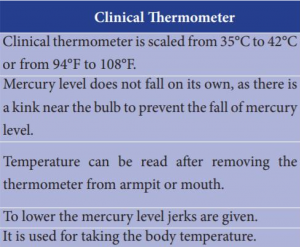 Incorrect
Incorrect
Explanation

-
Question 18 of 37
18. Question
18. Which of the following statement about Laboratory Thermometer is incorrect?
Correct
Explanation
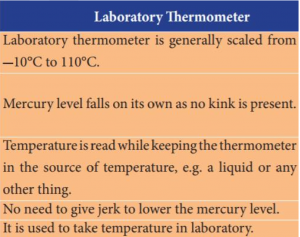 Incorrect
Incorrect
Explanation

-
Question 19 of 37
19. Question
19. Which of the following statement is correct?
1) Digital thermometers are available which use mercury along with a sensor
2) Digital thermometers are mainly used to take the body temperature
3) Mercury is a toxic substance and is very difficult to dispose of if a thermometer break.Correct
Explanation
Here is a lot of concern over the use of mercury in thermometers. Mercury is a toxic substance and is very difficult to dispose of if a thermometer break. These days, digital thermometers are available which do not use mercury. Instead, it has a sensor which can measure the heat coming out from the body directly and from that can measure the temperature of the body. Digital thermometers are mainly used to take the body temperature.Incorrect
Explanation
Here is a lot of concern over the use of mercury in thermometers. Mercury is a toxic substance and is very difficult to dispose of if a thermometer break. These days, digital thermometers are available which do not use mercury. Instead, it has a sensor which can measure the heat coming out from the body directly and from that can measure the temperature of the body. Digital thermometers are mainly used to take the body temperature. -
Question 20 of 37
20. Question
20. Assertion(A): We should not use Clinical thermometer to measure the temperature of hot milk
Reason(R): A Clinical thermometer has small temperature rangeCorrect
Explanation
Alex wanted to measure the temperature of hot milk using a clinical thermometer. His teacher stopped him from doing so. We are advised not to use a clinical thermometer for measuring the temperature of any object other than human body. A Clinical thermometer has small temperature range. The glass will crack/ burst due to excessive pressure created by expansion of mercury.Incorrect
Explanation
Alex wanted to measure the temperature of hot milk using a clinical thermometer. His teacher stopped him from doing so. We are advised not to use a clinical thermometer for measuring the temperature of any object other than human body. A Clinical thermometer has small temperature range. The glass will crack/ burst due to excessive pressure created by expansion of mercury. -
Question 21 of 37
21. Question
21. The temperatures of the previous day reported in weather reports are measured by____
Correct
Explanation
The maximum and minimum temperatures of the previous day reported in weather reports are measured by a thermometer called the maximum – minimum thermometerIncorrect
Explanation
The maximum and minimum temperatures of the previous day reported in weather reports are measured by a thermometer called the maximum – minimum thermometer -
Question 22 of 37
22. Question
22. After whom Celsius scale was termed?
Correct
Explanation
Celsius is the common unit of measuring temperature, termed after Swedish astronomer, Anders Celsius in 1742, before that it was known as Centigrade as thermometers using this scale are calibrated from (Freezing point of water) 0°C to 100°C (boiling point of water). In Greek, ‘Centium’ means 100 and ‘Gradus’ means steps, both words make it centigrade and later Celsius.Incorrect
Explanation
Celsius is the common unit of measuring temperature, termed after Swedish astronomer, Anders Celsius in 1742, before that it was known as Centigrade as thermometers using this scale are calibrated from (Freezing point of water) 0°C to 100°C (boiling point of water). In Greek, ‘Centium’ means 100 and ‘Gradus’ means steps, both words make it centigrade and later Celsius. -
Question 23 of 37
23. Question
23. Freezing point of water is taken as ___°F
Correct
Explanation
Fahrenheit is a Common unit to measure human body temperature. It is termed after the name of a German Physicist Daniel Gabriel Fahrenheit. Freezing point of water is taken as 32°F and boiling point 212°F. Thermometers with Fahrenheit scale are calibrated from 32°F to 212°F.Incorrect
Explanation
Fahrenheit is a Common unit to measure human body temperature. It is termed after the name of a German Physicist Daniel Gabriel Fahrenheit. Freezing point of water is taken as 32°F and boiling point 212°F. Thermometers with Fahrenheit scale are calibrated from 32°F to 212°F. -
Question 24 of 37
24. Question
24. Kelvin scale is termed after____
Correct
Explanation
Kelvin scale is termed after Lord Kelvin. It is the SI unit of measuring temperature and written as K also known as absolute scale as it starts from absolute zero temperature.Incorrect
Explanation
Kelvin scale is termed after Lord Kelvin. It is the SI unit of measuring temperature and written as K also known as absolute scale as it starts from absolute zero temperature. -
Question 25 of 37
25. Question
25. Match the following:
I. Boiling point of water (°C) 1. 37
II. Boiling point of water (°F) 2. 100
III. Mean temperature of human body (°C) 3. 212
IV. Room temperature (°C) 4. 72Correct
Explanation
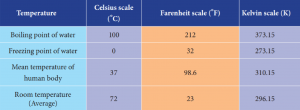 Incorrect
Incorrect
Explanation

-
Question 26 of 37
26. Question
26. Which of the following are equal?
1) (F – 32)/ 9
2) C/5
3) 9CCorrect
Explanation
 Incorrect
Incorrect
Explanation

-
Question 27 of 37
27. Question
27. Which of the following is Absolute zero Temperature?
Correct
Explanation
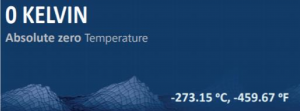 Incorrect
Incorrect
Explanation

-
Question 28 of 37
28. Question
28. _____maintains the coldest known natural temperature in the universe
Correct
Explanation
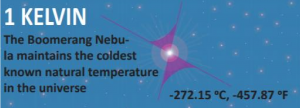 Incorrect
Incorrect
Explanation

-
Question 29 of 37
29. Question
29. Coldest natural temperature ever recorded on Earth is____
Correct
Explanation
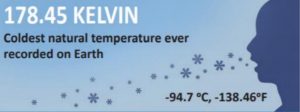 Incorrect
Incorrect
Explanation

-
Question 30 of 37
30. Question
30. Temperature of the Universe in the earliest moments after the Big Bang was ____
Correct
Explanation
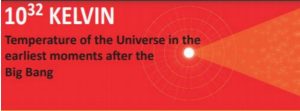 Incorrect
Incorrect
Explanation

-
Question 31 of 37
31. Question
31. Which of the following are the boiling point of water?
1) 100 °C
2) 212° F
3) 373.15 KCorrect
Explanation
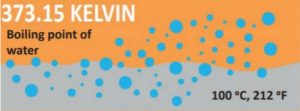 Incorrect
Incorrect
Explanation

-
Question 32 of 37
32. Question
32. Hottest natural temperature ever recorded on Earth
Correct
Explanation
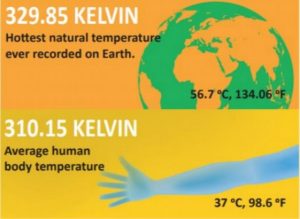 Incorrect
Incorrect
Explanation

-
Question 33 of 37
33. Question
33. Which of the following scale is used to measure temperature for day to day purpose?
Correct
Explanation
Most of the people in the world use the Celsius scale to measure temperature for day to day purpose.
The Kelvin scale has been designed in such a way, it is not only an absolute temperature scale, but
also 1°C change is equal to a 1K change. This makes the conversion from Celsius to absolute
temperature scale (Kelvin scale) easy, just the addition or subtraction of a constant 273.15.Incorrect
Explanation
Most of the people in the world use the Celsius scale to measure temperature for day to day purpose.
The Kelvin scale has been designed in such a way, it is not only an absolute temperature scale, but
also 1°C change is equal to a 1K change. This makes the conversion from Celsius to absolute
temperature scale (Kelvin scale) easy, just the addition or subtraction of a constant 273.15. -
Question 34 of 37
34. Question
34. United States prefer___ scale
Correct
Explanation
In United States they prefer to use the Fahrenheit scale. The problem is, converting Fahrenheit to
absolute scale (Kelvin) is not easy.Incorrect
Explanation
In United States they prefer to use the Fahrenheit scale. The problem is, converting Fahrenheit to
absolute scale (Kelvin) is not easy. -
Question 35 of 37
35. Question
35. Which of the following statement is correct?
1) The Rankine scale was named after the Glasgow University engineer and physicist Rankine,
who proposed it in 1859
2) It is an absolute temperature scale, and has the property of having a 1°R change is equal to a
1.5°F change.Correct
Explanation
The Rankine scale was named after the Glasgow University engineer and physicist Rankine, who
proposed it in 1859. It is an absolute temperature scale, and has the property of having a 1°R change
is equal to a 1°F change. Fahrenheit users who need to work with absolute temperature can be
converted to Rankine by R= F+ 459.67Incorrect
Explanation
The Rankine scale was named after the Glasgow University engineer and physicist Rankine, who
proposed it in 1859. It is an absolute temperature scale, and has the property of having a 1°R change
is equal to a 1°F change. Fahrenheit users who need to work with absolute temperature can be
converted to Rankine by R= F+ 459.67 -
Question 36 of 37
36. Question
36. How much will the temperature of 68°F be in Celsius?
Correct
Explanation
C = 5x 36/ 9 = 20°C
K = C + 273.15 = 20 + 273.15 = 293.15
Thus, the temperature in Celsius = 20 degree C and in Kelvin = 293.15 KIncorrect
Explanation
C = 5x 36/ 9 = 20°C
K = C + 273.15 = 20 + 273.15 = 293.15
Thus, the temperature in Celsius = 20 degree C and in Kelvin = 293.15 K -
Question 37 of 37
37. Question
37. At what temperature will its value be same in Celsius and in Fahrenheit?
Correct
Explanation
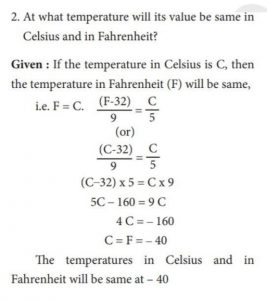 Incorrect
Incorrect
Explanation

Leaderboard: Heat and Temperature Online Test 7th Science Lesson 7 Questions in English
| Pos. | Name | Entered on | Points | Result |
|---|---|---|---|---|
| Table is loading | ||||
| No data available | ||||